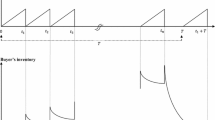Abstract
The loss and damage of goods during shipment is a very common risk that business owners often incur as a part of daily operations. For this reason, the shipper may have to make a claim for lost or damaged items. In this study, a claim policy to improve the flow and coordination of the vendor–buyer inventory shipment process is developed. The model assumes some of the goods are lost or damaged during production and shipment. The buyer incurs an insurance cost which corresponds the market value of the item. The stochastic lead time is a function of production, transportation, in-transit and delay times. The objective of the coordinated vendor–buyer model is to minimize the total cost for both parties. An algorithm to optimize the independent and coordinated policies is created. Finally, numerical examples and sensitivity analysis are given to illustrate the theory.








Similar content being viewed by others
References
Cheikhrouhou N, Sarkar B, Ganguly B, Malik AI, Batista R, Lee YH (2018) Optimization of sample size and order size in an inventory model with quality inspection and return of defective items. Ann Oper Res 271(2):445–467
Chen CK, Lo CC, Weng TC (2017) Optimal production run length and warranty period for an imperfect production system under selling price dependent on warranty period. Eur J Oper Res 259(2):401–412
Daryanto Y, Wee HM, Astanti RD (2019) Three-echelon supply chain model considering carbon emission and item deterioration. Transp Res Part E Logist Transp Rev 122:368–383
Eroglu A, Ozdemir G (2007) An economic order quantity model with defective items and shortages. Int J Prod Econ 106(2):544–549
Goyal SK, Cárdenas-Barrón LE (2002) Note on: economic production quantity model for items with imperfect quality–a practical approach. Int J Prod Econ 77(1):85–87
Goyal SK, Huang CK, Chen KC (2003) A simple integrated production policy of an imperfect item for vendor and buyer. Prod Plan Control 14(7):596–602
Hsu LF (2012) A note on “An economic order quantity (EOQ) for items with imperfect quality and inspection errors”. Int J Ind Eng Comput 3:695–702
Huang CK (2004) An optimal policy for a single-vendor single-buyer integrated production–inventory problem with process unreliability consideration. Int J Prod Econ 91(1):91–98
Jauhari WA (2016) Integrated vendor-buyer model with defective items, inspection error and stochastic demand. Int J Math Oper Res 8(3):342–359
Khan M, Jaber MY, Bonney M (2011) An economic order quantity (EOQ) for items with imperfect quality and inspection errors. Int J Prod Econ 133(1):113–118
Konstantaras I, Goyal SK, Papachristos S (2007) Economic ordering policy for an item with imperfect quality subject to the in-house inspection. Int J Syst Sci 38(6):473–482
Lopes R (2018) Integrated model of quality inspection, preventive maintenance and buffer stock in an imperfect production system. Comput Ind Eng 126:650–656
Maddah B, Jaber MY (2008) Economic order quantity for items with imperfect quality: revisited. Int J Prod Econ 112(2):808–815
Papachristos S, Konstantaras I (2006) Economic ordering quantity models for items with imperfect quality. Int J Prod Econ 100(1):148–154
Porteus EL (1986) Optimal lot sizing, process quality improvement and setup cost reduction. Oper Res 34(1):137–144
Rosenblatt MJ, Lee HL (1986) Economic production cycles with imperfect production processes. IIE Trans 18(1):48–55
Salameh MK, Jaber MY (2000) Economic production quantity model for items with imperfect quality. Int J Prod Econ 64(1):59–64
Sarkar B, Saren S (2016) Product inspection policy for an imperfect production system with inspection errors and warranty cost. Eur J Oper Res 248(1):263–271
Sett BK, Sarkar S, Sarkar B (2017) Optimal buffer inventory and inspection errors in an imperfect production system with preventive maintenance. Int J Adv Manuf Technol 90(1–4):545–560
Soni HN, Sarkar B, Mahapatra AS, Mazumder SK (2018) Lost sales reduction and quality improvement with variable lead time and fuzzy costs in an imperfect production system. RAIRO Oper Res 52(3):819–837
Swenseth SR, Buffa FP (1990) Just-in-time: some effects on the logistics function. Int J Logist Manag 1(2):25–34
Swenseth SR, Godfrey MR (2002) Incorporating transportation costs into inventory replenishment decisions. Int J Prod Econ 77(2):113–130
Tiwari S, Daryanto Y, Wee HM (2018) Sustainable inventory management with deteriorating and imperfect quality items considering carbon emission. J Clean Prod 192:281–292
Wang CH (2005) Integrated production and product inspection policy for a deteriorating production system. Int J Prod Econ 95(1):123–134
Wangsa ID, Wee HM (2017) An integrated vendor-buyer inventory model with transportation cost and stochastic demand. Int J Syst Sci Oper Logist. https://doi.org/10.1080/23302674.2017.1296601
Wee HM, Yu J, Chen MC (2007) Optimal inventory model for items with imperfect quality and shortage backordering. Omega 35(1):7–11
Wee HM, Wang WT, Yang PC (2013) A production quantity model for imperfect quality items with shortage and screening constraint. Int J Prod Res 51(6):1869–1884
Acknowledgements
We would like to thank the journal editors and three anonymous reviewers for valuable comments and helpful suggestions on manuscript of this article.
Author information
Authors and Affiliations
Corresponding author
Ethics declarations
Conflict of interest
There is no potential conflict was reported by the authors regarding the publication of this article.
Additional information
Publisher's Note
Springer Nature remains neutral with regard to jurisdictional claims in published maps and institutional affiliations.
Rights and permissions
About this article
Cite this article
Wangsa, I.D., Wee, H.M. & Tseng, SH. A coordinated vendor–buyer system considering loss and damage claims, insurance cost and stochastic lead time. Int J Syst Assur Eng Manag 10, 384–398 (2019). https://doi.org/10.1007/s13198-019-00792-y
Received:
Revised:
Published:
Issue Date:
DOI: https://doi.org/10.1007/s13198-019-00792-y




